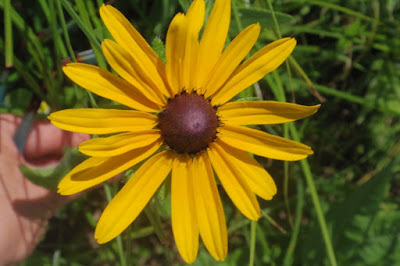Today’s blog post is about plants. It’s about flowers and weeds and invasive species. The concept of a weed is very subjective.
What one person thinks of as a wild flower and worthy of a space in the garden is a weed to someone else and deserving of eradication. I had one gardening customer who didn’t like daisies and wanted me to remove all of them. He also didn’t like mint and had me dig up all of the mint. The mint was persistent and kept returning, much to his chagrin.
Some plants that have been characterized as weeds are actually helpful and even nutritious.
As an example, dandelions are very unwelcome in most gardens and lawns. People go out of their way to eradicate dandelions, to the point of attacking them with monumental blasts of lawn chemicals. It’s really not a good idea. Dandelions attract pollinators to the garden, while lawn chemicals are not bee friendly.
Dandelions are also highly nutritious: they offer loads of vitamin K, vitamin A, vitamin C, and more. Another nutritious plant that people think of as a weed is wood sorrel. It looks like clover, except that it has heart shaped leaves, instead of rounded leaves. It has a light lemony flavor and is high in vitamin C and also has some vitamin A. It is a great addition to a salad.
Invasive plants, on the other hand, are yuck. There are numerous types of invasive plants. Some of them are actually dangerous to touch. One of the most dangerous is giant hogweed. According to the New York State Department of Environmental Conservation, contact with giant hogweed can result in permanent scarring, blistering, blindness, and severe skin and eye irritation. It is far worse than poison ivy. It is a member of the carrot family and is a very large plant, with giant leaves and flowers. If you see it, take a photograph but do not touch! Only specially trained people are able to eradicate giant hogweed. If you are in New York State and you see giant hogweed, call the DEC hotline at 1-845-256-3111.
Another invasive plant is purple loosestrife.
It is quite attractive but it causes problems for native animals and plants by forming dense, impenetrable stands, which chokes out native vegetation. The best thing to do with that is to eradicate. You can just dig it up by the roots.
Today’s question: what are some of your favorite plants? What plants do you dislike having in your garden and why?





Who would have thought that plants could be evil! I personally hate cacti and think they look evil. But most flowering plants hold a special appeal for me . I live in an apartment so the only flowers I see are the ones in a vase! So thanks for sharing this information and the pretty flowers
Nice article, but maybe it is we who feel evil when we see that cloud of dandelions as opposed to daffodils. Strange, when I was young, we were thrilled to find those white fluffy heads to puff on and spread our wishes off as we blew. Now, I know the horror those innocent little puffs can cause.
I worry about the invasive species- even if they have benefits. They are termed invasive because they grow at the expense of the naturally occurring, which leads to the loss of species.
Now, there are a few humans…
So many invasives in our area – probably many are the same as yours as we don't (geographically) live that far from each other. We have hogweed, yes – and it is as horrible as you say it is. Some invasives are favored by bees at the expense of native plants, which is part of the problem they pose (I'm thinking here of Japanese knotweed). Where I lived in Arkansas years ago, we had battles galore with an invasive called Johnson Grass, which could poison cattle and popped up everywhere in our garden.